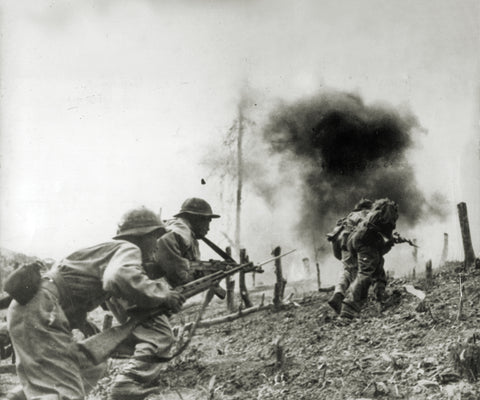
How Communist Forces “Hugged” American Units in Battle
Pitted against the combined arms capabilities of the U.S. military, the light infantry forces of the Viet Cong and the North Vietnamese Army developed a variety of tactics to minimize the destructive effects of American firepower. Staying close to or “hugging” American units in battle (also known as “grabbing or clinging to the enemy’s belt”), a tactic the Viet Minh employed in the First Indochina War, was arguably one of the most effective.
Gen. Nguyen Chi Thanh formalized the use of “hugging” tactics while serving as party secretary of the communist Central Office for South Vietnam (COSVN) in 1965. Thanh, upon learning that a squad leader in a Viet Cong main-force regiment had shouted, “Grab the enemy’s belts to fight them,” while fighting the South Vietnamese, ordered all communist units to adopt the rallying cry as a slogan when fighting U.S. forces.
If their troops could move in quickly and engage at close range, Thanh and other communist leaders concluded, American commanders would not be able to call in air strikes or artillery fire without risking friendly casualties. “But in order to fight the Americans, you had to get close to them,” recalled one Viet Cong veteran. “You couldn’t fight them from a distance.” Close- quarters infantry fights between two otherwise evenly matched opponents thus offered the opportunity to win battles and kill Americans at an acceptable cost.
this article first appeared in vietnam magazine
In a 1966 summary, U.S. Military Assistance Command, Vietnam acknowledged that “during attacks the NVA/VC used hugging tactics as a means of protecting themselves from Allied artillery and air strikes.” To counter this approach, some American units attempted to pull back from contact to allow for the delivery of close-in supporting fire. Senior Col. Hoang Cam witnessed the technique firsthand. Commanding the 9th Viet Cong Division at the time, Cam noted the Americans “usually tried to achieve separation between their forces and ours to provide a fire support zone in which their heavy fire support weapons could inflict casualties on their opponents.”
Lt. Col. George Shuffer’s 2nd Battalion, 2nd Infantry (1st Infantry Division) succeeded in doing exactly that at Ap Nha Mat in December 1965. As the lead elements of the battalion approached an enemy base camp north of the hamlet, a regiment from Cam’s 9th Viet Cong Division attacked the startled Americans.
“The enemy, practicing his newly adopted ‘hugging tactics,’” wrote Shuffer, “came out of his craftily fortified camp in force to meet us.”
While his infantry unleashed a torrent of small-arms fire, keeping the Viet Cong back and preserving the space required to bring in supporting arms, Shuffer hammered the attackers with artillery, air strikes, and helicopter gunships. Later that afternoon, the Americans counterattacked and routed the enemy. Badly beaten, the Viet Cong withdrew, leaving some 300 dead behind. Shuffer suffered 39 killed.
More often than not, however, the enemy’s ability to “hug” U.S. units prevented the latter from leveraging all their available firepower. That failure to maintain tactical separation, for example, delayed the delivery of critical fire support at Landing Zone Albany in November 1965. Charging out of the grass and jungle surrounding the modest clearing, a composite battalion of the 66th NVA Regiment ambushed the 2nd Battalion, 7th Cavalry (1st Cavalry Division Airmobile).
Within minutes, a savage and close-quarters struggle—some of it hand-to- hand—engulfed the entire American column. An American fire support officer circling overhead in a helicopter recalled that he had artillery, gunships, and air support on hand to assist the embattled cavalrymen but “couldn’t do a damn thing” because of the intimate nature of the fighting.
The cavalry battalion fought for over an hour before soldiers on the ground or in the air could bring any of that firepower to bear. When the battle finally ended, an estimated 151 Americans had been killed and 121 wounded—figures that added up to a casualty rate of nearly 70%. North Vietnamese losses, though almost certainly less than American estimates, were nevertheless significant.
Interestingly, Lt. Col. (later Maj. Gen.) George Smith Patton, son of the famed World War II commander, published an article in late 1965 highlighting the results of a questionnaire he had forwarded to dozens of American and Vietnamese servicemen, government officials, press, and other individuals who had either served in Vietnam or were in some way connected to the conflict. Patton inquired about the factors that motivated Viet Cong main-force soldiers and solicited comments on their “willingness to close with and destroy the enemy.”
Addressing the question of close combat, one high-level American military adviser echoed an opinion shared by many of the respondents. “This willingness varies directly with the Viet Cong’s tactical chances of success,” the officer explained. “Viet Cong units will not normally close unless chances for success are in their favor.”
historynet magazines
Our 9 best-selling history titles feature in-depth storytelling and iconic imagery to engage and inform on the people, the wars, and the events that shaped America and the world.
